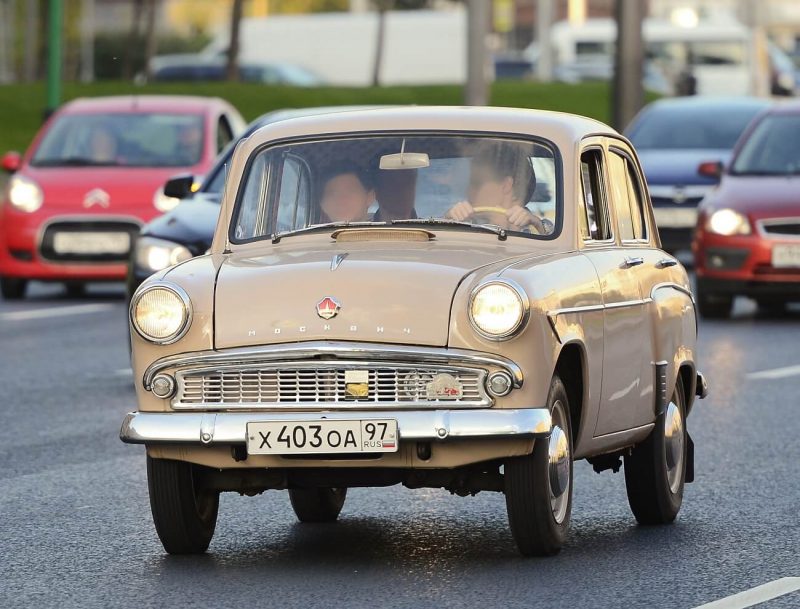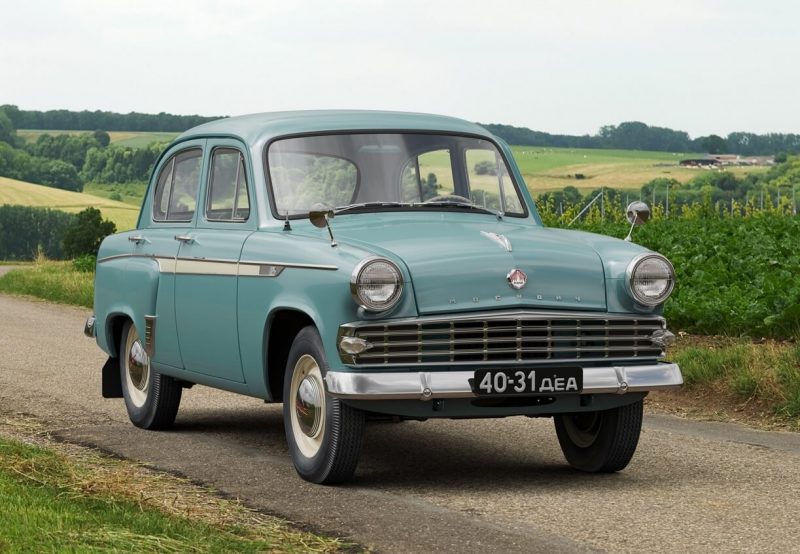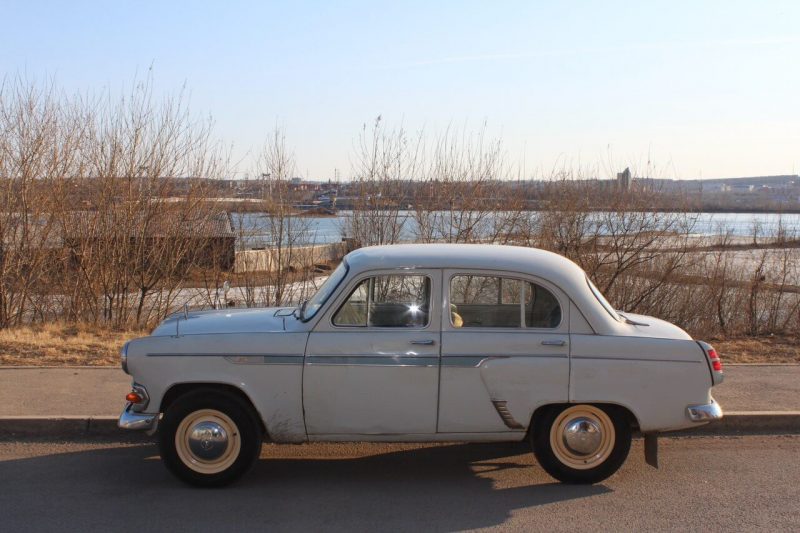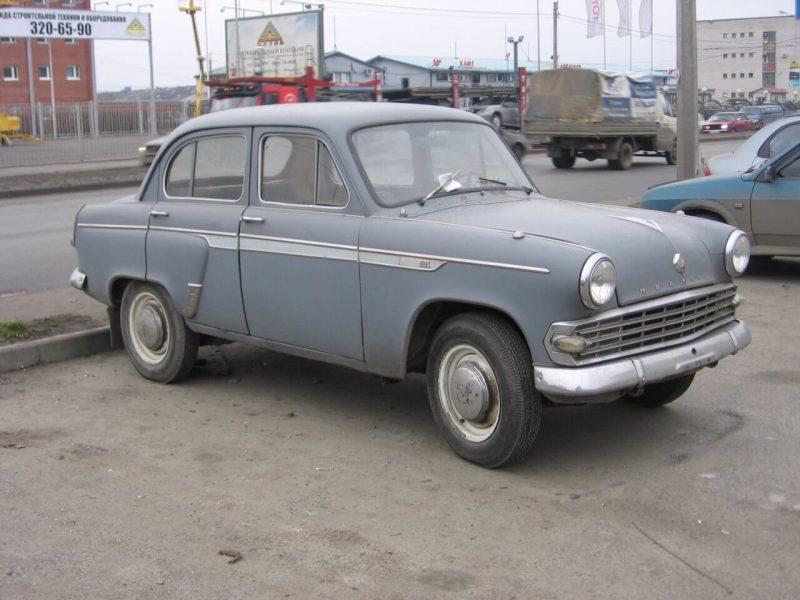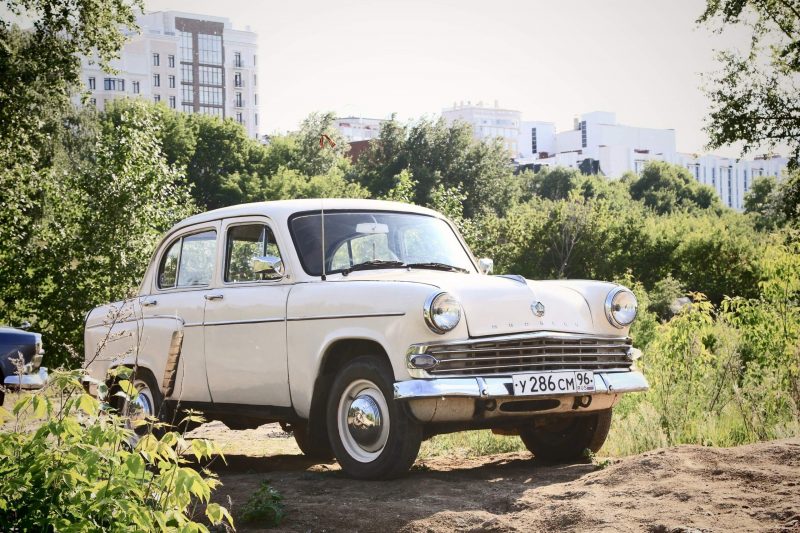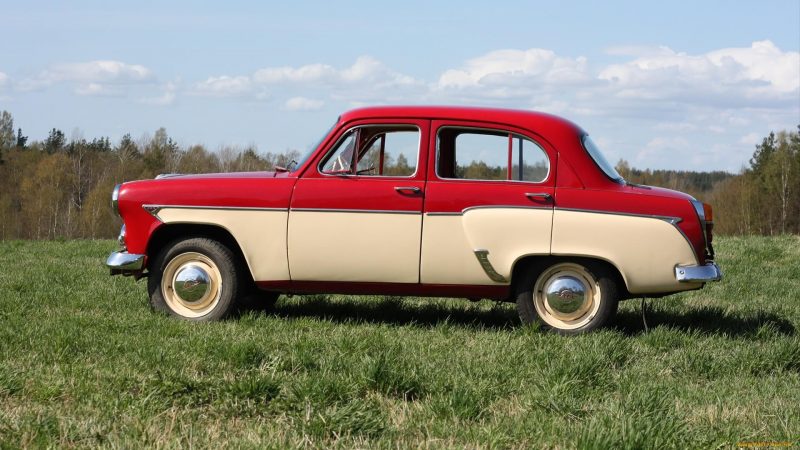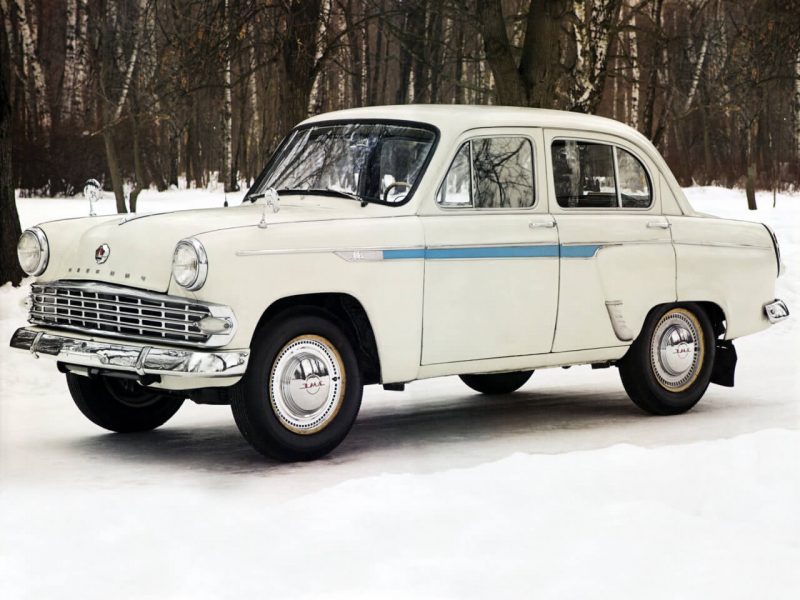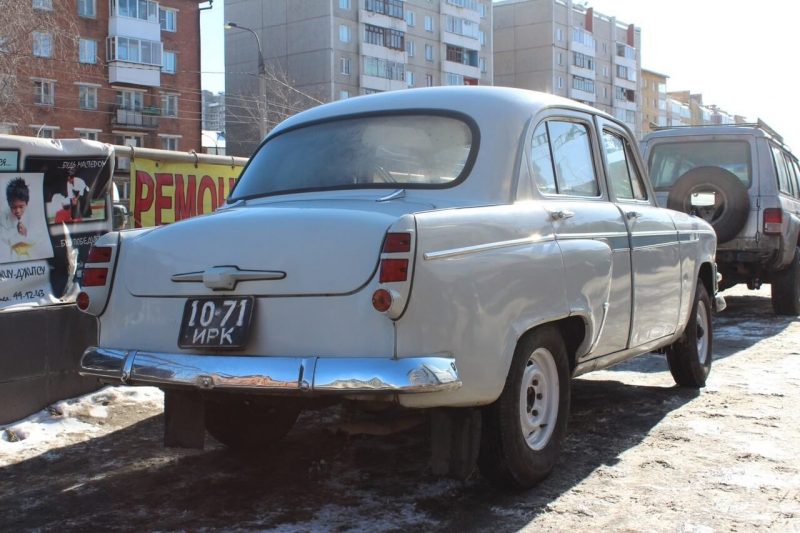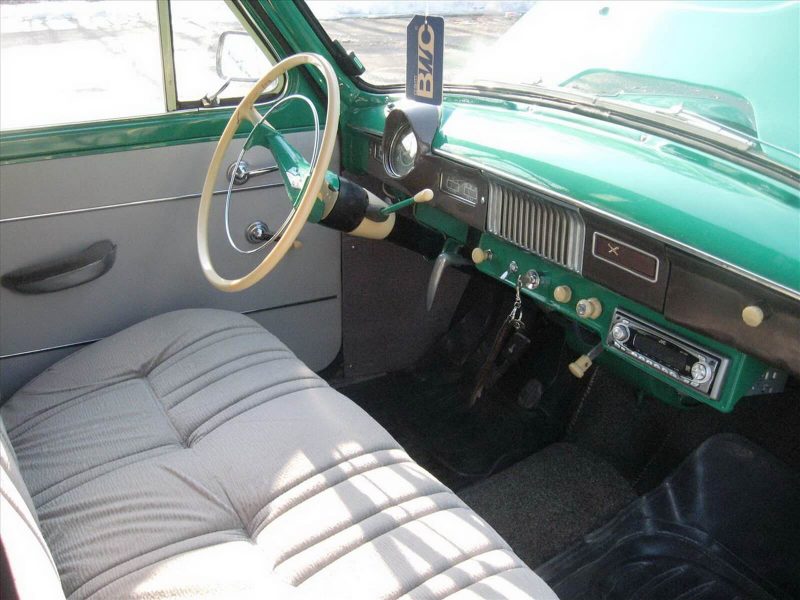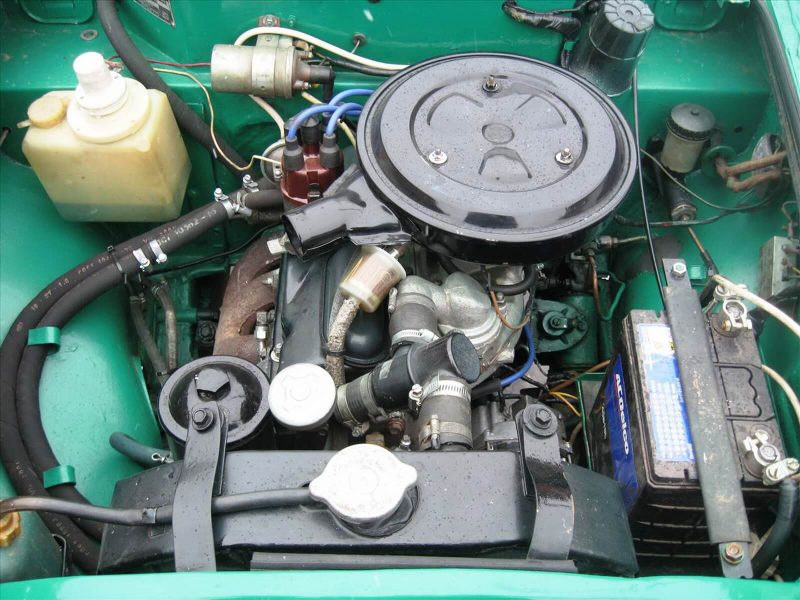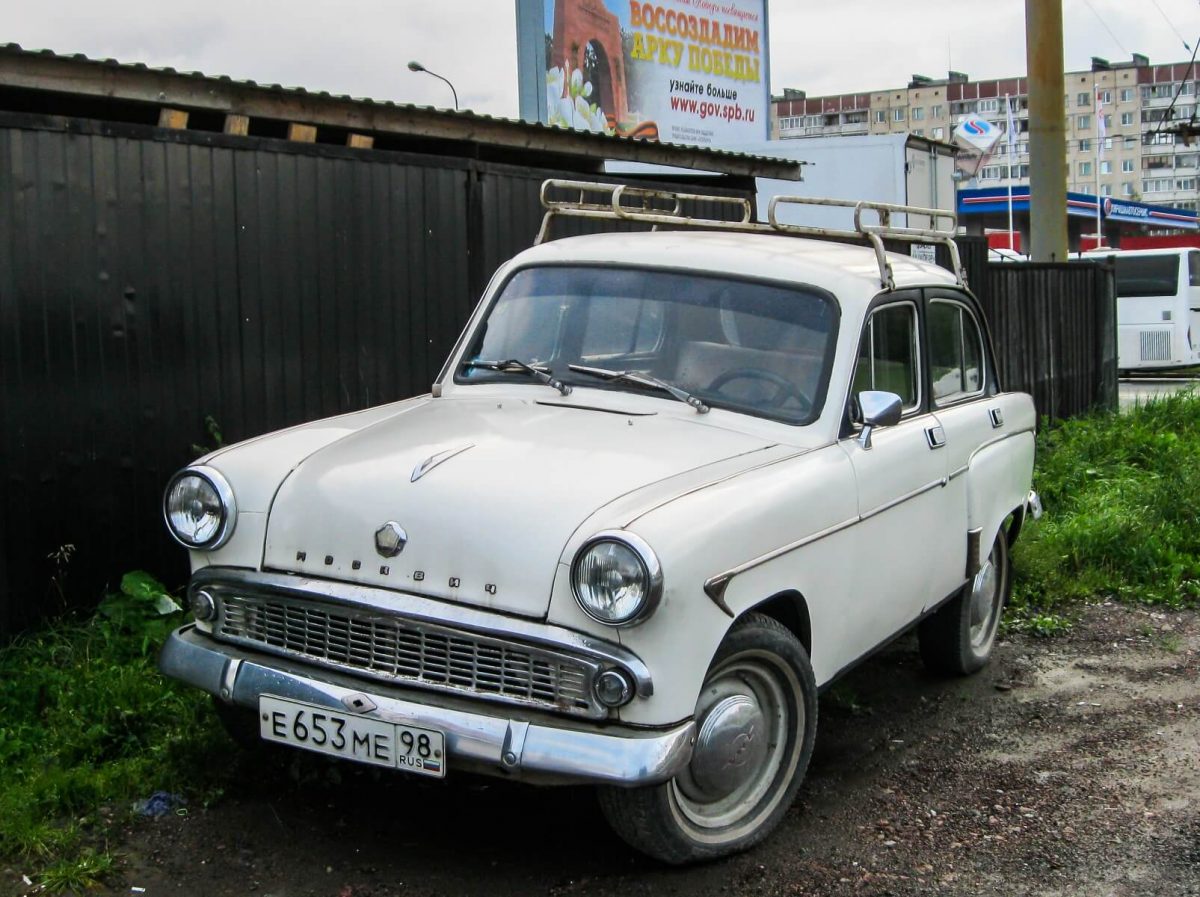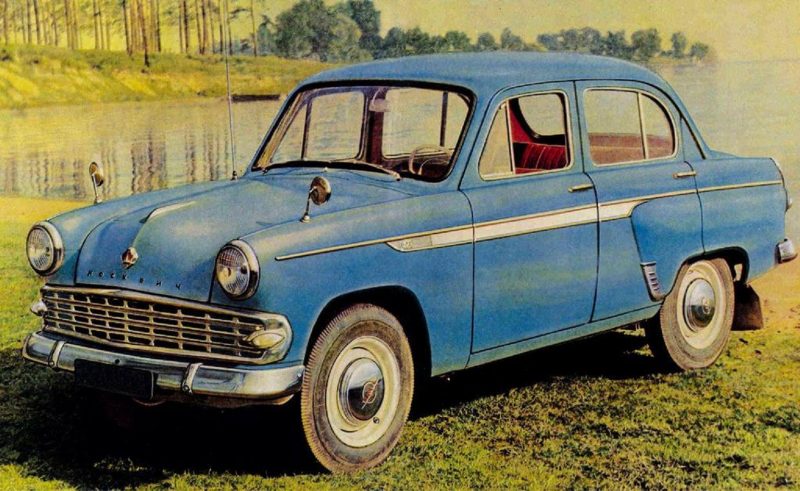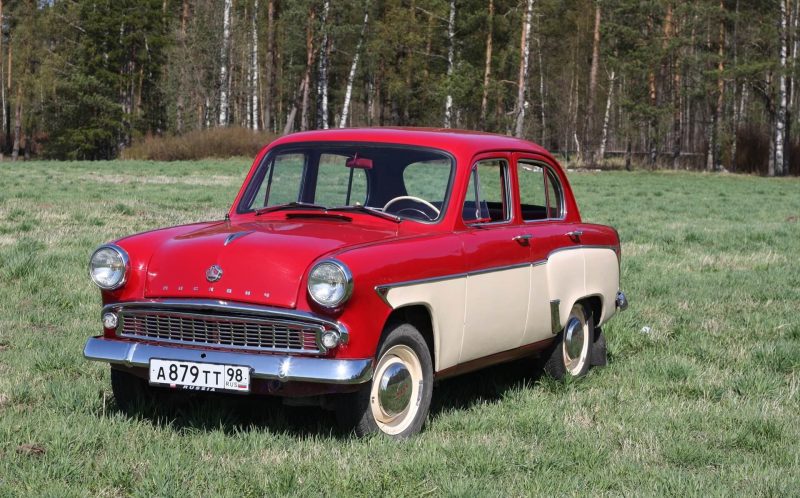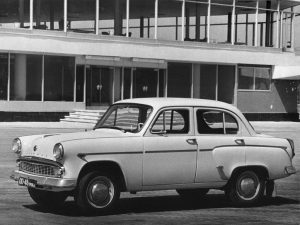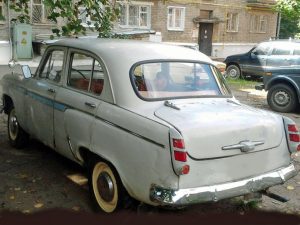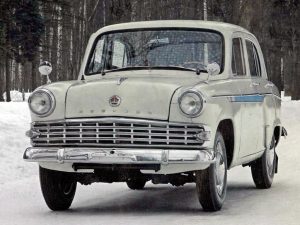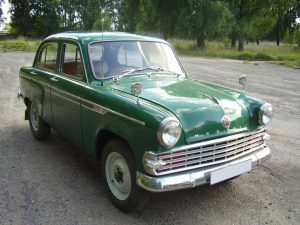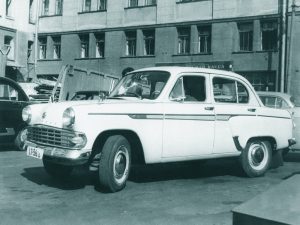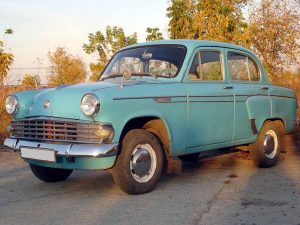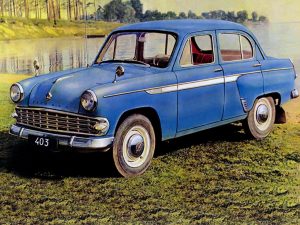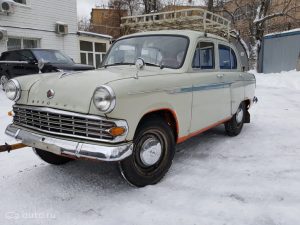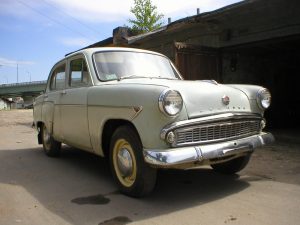Moskvich-403
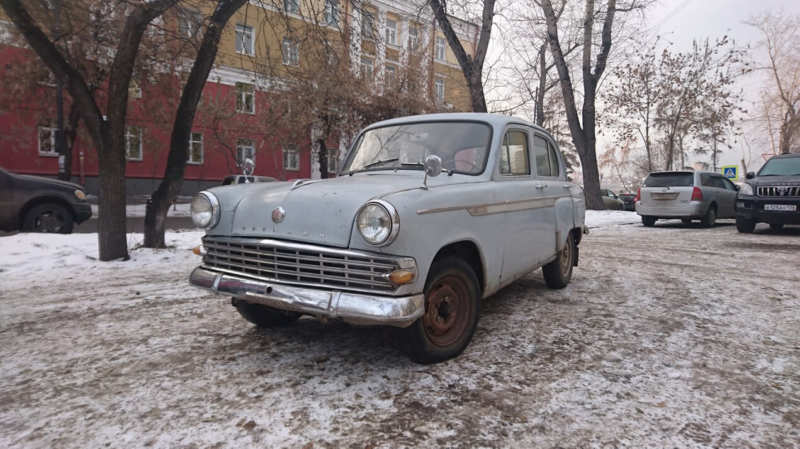
The Moskvich 403 is a small Soviet passenger car produced at a small-capacity car factory in Moscow from winter (December) 1962 to summer (July) 1965. The model is a transitional variant of the Moskvich-407 model, which was in serial production until 1963, and the Moskvich-408th model, which went into serial production in 1964. The whole model range is Moskvich.
Car history
In total, this vehicle was produced in 105,726 copies. At the beginning of October 1963, the last car of the M-407 brand was produced from the serial production of the automobile enterprise. The management of the company decided to completely switch over to the production of the transitional car M-403, the construction of which was started in parallel with the previous car at the end of 1962.
It was in this year that the Gorky Automobile Plant mastered the production of the 21st Volga of the third generation, and the Zaporozhye specialists had already finished the upgraded version of the car with the index “A”, which was also called “humpback”.
On the whole, these are all the rivals of the cars produced by the Moscow plant (naturally, without taking into account the foreign options). Among Moskvich-407’s “trump cards” there was its availability, because not everyone could buy the famous Volga, and Zaporozhets was losing in power, dynamic component, comfort level and so on. To be more precise, the Moskvich cost about 2 500 rubles and had good consumer qualities and technical characteristics, which made the 407th model in demand and popular.
It is not a bad thing to call the environment that prevailed in the foreign market a bad thing. Of the 360000 machines produced (M-407), one in three was exported. By the early 1960s, the car in its class was not even inferior to foreign variations. In other words, the managers of the Moscow plant could not puzzle over the future upgrades of the 407th, and all their engineering capabilities could be used in the preparation of a new basic machine. But this did not happen. The production and technological systems of the policy of the Moscow enterprise were based on the idea of a smooth transition from one vehicle to another by means of gradual replacement of functioning units and assemblies with newer ones.
The development of the third generation 408th model began in 1959, and a couple of years later (in 1961), the debut prototypes were prepared. Therefore, it is quite logical that the next step was almost imperceptible introduction of new elements into the structural component of the produced car. It is worth admitting that this time the transition was considerably delayed, because the 408th one was very different from the previous cars. It was necessary to create a special intermediate model, which was called Moskvich-403.
Transients in the status of the new car were reflected even in its name. Starting with M-400, all new standard vehicles manufactured at the Moscow Automobile Plant purchased the index in order, depending on the model of the power unit. And only for the 403rd model an exception was made – to emphasize the temporary, intermediate component of the car, it was decided to make it “younger” than its regular relatives.
And it’s worth saying that the role of the 403rd transitional car was coped with perfectly. In the debut year of production he shared the assembly line with the 407th, and since the autumn of 64th year the model was produced in parallel with the new standard machine – Moskvich-408. It will not be superfluous to mention that the buyers of such a “transition” of a new small-capacity car cost in the next rise in price by as much as 900 rubles. During the drawing of the lottery “Sportloto” the price of this car was 3,411 rubles 25 kopecks.
Exterior
The basic model of the 403rd car was almost no different from the exterior of the 407th model, except for the rear lights, which were already three-piece filled against the two-piece model. Only the “export” variant (in reality, both variants of the design were on sale abroad, as different equipment) of the modifications (M-403E) had a modified design – there was a wide radiator grille, where there were rectangular shapes, modified (“two-storey”) side molding, painted under the body color of the rear lights and exterior mirrors of rear visibility.
The main mass of the trucks was of standard design. Instead of outdated fangs at the junctions of bumper parts, small overlays were installed. On the front wing ornament insert, instead of the number “407” the index “403” was installed.
The newest beauty in automotive design, which was able to stir up the automotive industry in America after the 2nd half of 1950s, reached the European countries, and after the Union of Soviet Socialist Republics. From the beginning of the 60s, the pompous and heavy appearance of the Muscovites (402, 407 and 403), as well as the 21st Volga, began to lose ground to more concise and functional design solutions of the “new wave”, a good example of which was the 408th Moskvich.
Automobile exports of the Soviet Union were hoping to enter foreign markets of the new MZMA car, but it was obviously not superfluous to insure for the next two years. It would be wrong to say that the 407th model in the foreign market looked like a very archaic machine, but in order to maintain its position it needed “reaestalizing”. As a result, it was decided to produce it. Everything started with, strange as it may seem, the works of Italian designers.
Motorists of the history of the Soviet automobile construction will know the case with the modernization of the 21st Volga. At the end of the 60th year, the Belgian importer company Scaldia decided to order GAZ-21 of the second generation from the popular Turin body shop Ghia “facelift”. Italian bodybuilders offered a rather unexpected variation of the radiator lining. As a result, a modest number of vehicles, where there were diesel engines, were sold in Brussels under the name of Voiga-Ghia.
However, not everybody knows that in the year 62, on the importers’ request, Ghia was able to “rejuvenate” the 407th model of Moskvitch in a similar way. As a result, the companies that sold the Moskvich car abroad, together with the Italian design staff, were able to provide excellent assistance to the Moscow plant. They were able to demonstrate what should be done to increase the demand for domestic vehicles in foreign markets, and even managed to create a role model.
Export options
The most debut export modifications had some distinguishing letters from the following modifications: 403E, 403Y, 403SE, 403K, 424E, 424Y, 424SE, 424K, 432Y and 432SE. The domestic export variation of Moskvich 403IE appeared in 1962. Repeating after the Italian model, the next time we decided to change the radiator lining, which became more elegant and modern. Corners of the facing, which came to the side surfaces of the wings installed in front, could indivisibly place the “crystals” of the new collar-braces.
Such, after some time, were planned to install on the 408th Muscovites. Moldings, installed on the sides, decided not to reduce. Moreover, they were increased. They became double in the middle part, which provided an opportunity to make an insert of a different color. This, in turn, made it possible to maintain demand abroad, as two-color vehicles were still popular there. For some reason, they decided not to use chrome on the rear light bodies. Now they were painted under the body color, and the glazing area looks smaller.
The metal “bird”, which was at the same time the handle of the luggage compartment lid and the lantern lamp lamp to illuminate the number plate, was also slightly altered. As a result, it was already “geometrically” accentuated and more angular. Interestingly enough, many motorists mistakenly consider only the export version of the 403rd Moskvich to be true. However, this denies the right to have their own name to all other cars of the Moscow Automobile Enterprise of the 2nd family, which were produced in the period from 1962 to 1965.
Interior
Inside Moskvich 403rd revolutionary decisions should not wait, but what western car could boast of the presence of a two-band, five-lamp receiver in the role of basic interior equipment? The steering wheel, despite the fact that it was made in the stylistic solution of “dilapidated” models, where light tones prevailed, but in constructive terms could almost fully transform.
It became more ergonomic and modern. It wouldn’t be superfluous to mention that the 408th model of Moskvich, as well as the 412th model of this steering wheel moved almost without changes. Except that, the color of coloring has changed from light to black.
If we talk about the turntable lever, it moved to the left side of the steering column, and before it was installed from above. A small sun visor could be seen above the speedometer. The interior was finished with a new type of leatherette, which did not have a fabric base. Also, the gearbox control device was changed, which, together with a new compact device for turning, made it possible to design a steering column and get rid of the decorative shell, which was on the steering wheel.
Car modifications
| Moskvich-403 | was the base model in the sedan body. It was produced from 1963 to 1965. |
| Moskvich-403B | represents a machine that was manually operated by the disabled. |
| Moskvich-403M | represents the medical version. Similar machine as its previous model was used for transportation of medical personnel and home care of patients. The windshield and rear window on such vehicles had special Red Cross signs. |
| Moskvich-403T | is a modification to work in a taxi company. The model had a counter, a lantern of green color, which was placed in the corner of the windshield, on the right, as well as “checkers”, which were installed on the front door. |
| Moskvich-403IE | “export execution”. The car differed in the form of a radiator grille, where there were corner lamps, other moldings, rear lights and “bird” above the rear license plate. Non-replacement of body parts of this modification from the 403rd model stood in the front wings (the export version had a fundamentally different facing of the radiator, as well as front lamps, differently located holes for fixing other moldings), doors and rear wings. The salon already had a new type of leatherette on a non-woven base, from which the ceiling upholstery was made. Moreover, the “export version” had an external mirror, which was placed on the left wing. |
| Moskvich-403Yu | represents a modification for the southern climate. |
| Moskvich-424 | is a universal and was created on the platform of Moskvich-423H, where there were angular frames of the rear doors and a solid gutter along the roof. The rear mounted seat could be folded up, which resulted in a cargo area with a length of 1,473 mm and a width of 1,220 mm. When the rear seats were folded together, the vehicle with a wagon body was able to transport 250 kg of cargo and a couple of passengers, including the driver. The spare wheel had a specially designed horizontal niche. The rear mounted springs were 5 millimeters wider than the standard car in the sedan body. The rear door had a loading height of 760 millimeters and opened to the left. This modification was made from 1963 to 1965. |
| Moskvich-424E | represents the export version of the Moskvich 424th universal. The appearance of the machine was similar to the standard sedan. |
| Moskvich-432 | van. This modification is a further development of the design of the 430th model, where there were assemblies and units from the 403rd Moskvich. The 432nd model had an all-stamped body sidewall, as opposed to the 430th model. Although, it should be said that they had to use an auxiliary profile stand. But the structural component, along with the manufacture of the body, was simplified. Rear visibility mirrors were introduced, which were installed on the front wings, which, in turn, allowed to abandon the window in the rear door and the window in the partition between the passenger and cargo compartments. The vehicle was produced since 1963 and finished in 1965. |
Specifications
Power pack
Due to the fact that the 403-nd model was called a transition, and in another way, if you say, it received a list of technical upgrades, which a little later began to use in Moskviche-408. It is very interesting that the improvements, which were originally designed for the 408th car, were so successful for the 403rd car that both machines for some time were produced by the Moscow plant of small cars in parallel. Initially, the car was equipped with a 407D engine.
From the 407th car itself, it was dislodged only by displacement of the front suspension adapter of the power unit by 15 millimeters back, as well as by mounting the hydraulic clutch drive. Later, in 1964 (April), it was replaced by the 407D1 powerplant, which was a transitional model to the M-408. It was installed not only on the 403rd model, but also on its modifications “Moskvich-424” – a station wagon and 432nd model – a van. Speaking of power and efficiency, this engine did not retail anything from the 407th and 407th-D engines, but had increased reliability and durability.
It had a whole list of upgraded elements. Among them, there was a crankshaft with enlarged main journals, 57 mm in diameter (51 mm in diameter before), crankshaft flywheel, cylinder block, where there were enlarged beds for the main journals of the crankshaft, main bearing shells, crankcase tray, ignition distributor.
In addition, the presence of the crankshaft gland (previously it was replaced by a shoulder with oil-carving thread) and other parts was installed. The engine was a four-cylinder in-line eight-valve 1.360-liter engine. As a result, it allowed to develop 45 horsepower. The maximum speed was 115 kilometres per hour and the average urban fuel consumption was 10 litres per 100 kilometres. The first hundred was achieved in a modest 36 seconds. This “experimental” engine made the 403rd more sharp and dynamic than the same Zaporozhets.
The engine has received numerous improvements that allowed it to be used in other models of the Moscow Automobile Enterprise. The latest Moskvich-403 cars, according to some information, could go along with the engine, which was a two-chamber carburetor. It already produced 50 horses and was installed on the 408th model. The car had a new radiator with a higher cooling capacity of the power unit.
Transmission
Transmission. Synchronized the engine and wheels with a four-speed manual gearbox. The clutch drive was already equipped with a hydraulic booster, which ensured smoother operation of the pedal.
Suspension
The front suspension was an independent spring with transverse levers. The suspension was hingeless and assembled on a pressed crossbar. The rear suspension was placed on a pair of longitudinal semi-elliptic leaf springs. There were hydraulic telescopic shock absorbers. It turns out that Moskvich had an improved front suspension. There were two ball joints on each side.
Brake system
The main brake cylinder was moved from under the bottom of the car to the underbody space, which made it possible to make not a floor variation of pedals, but a suspended one, which is still used today. All wheels were equipped with drum brakes.
| Body | |
| Body type | sedan |
| Number of doors | 4 |
| Number of seats | 4 |
| Length | 4040 mm. |
| Width | 1540 mm. |
| High | 1600 mm. |
| Wheelbase | 2380 |
| Far | 1225 |
| Rearring Gauges | 1220 |
| Engine | |
| Location | front, longitudinally |
| Size | 1360 cm³ |
| Cylinder type | row |
| Number of cylinders | 4 |
| Piston stroke | 75 mm. |
| Cylinder diameter | 76 mm. |
| Compression | 7 |
| Number of valves | 2 |
| Power system | carburetor |
| Power | 45/4500 hp |
| Torque | 88/2600 n.m. |
| Fuel | AI-80 gasoline |
| Transmission | |
| Transfer ratio of the main pair | 4.55 |
| Drive | back |
| Number of transmissions | 4 |
| Performance | |
| Tank volume | 35 l |
| Maximum speed | 115 km/h |
| Fuel consumption on the highway | 6.5 l/100 km |
| Fuel consumption in the city | 10 l/100 km |
| Clierence | 200 mm |
| Permissible Gross Mass | 1280 kg |
Pluses and minuses
Pluses cars
- Little car value;
- More powerful power unit than its predecessor;
- Appceptable ground clearance height;
- There’s a radio
- Application of modern (at that time) technologies in the creation of the front suspension;
- The pedals were pendant type (previous models had floor pedals);
- Hydraulic brake booster;
- Sedan’s small size;
- Released in an export version;
- There are various modifications;
- Low car weight;
- There’s a special place for a spare wheel.
Cons of a car
- Like appearance did not reach foreign options;
- He had no hydraulic power steering;
- No seat-belts;
- Little free space inside the machine;
- Not adjustable steering column and driver’s seat
- Large steering wheel;
- Small fuel tank;
- weak battery;
- Small luggage compartment.
We sum up
Only in 3 years about 133.5 thousand models of 403 models were removed from the Moscow Automobile Company. Although, the car was initially as an experimental one, but was able to get quite a wide execution. Moreover, many important assemblies and units moved to other models, such as Moskvich-408. The car was so successful that it was exported to many countries.
In the same other countries, it was repeatedly subjected to raistling, which gave it an even more presentable look. There were those who did not like the long and cumbersome 21st Volga. Therefore, a small sedan was perfectly included in the list of “people’s car”, which allowed it to be more powerful than its direct rival (in the domestic market) – Zaporozhets.
Although the model did not have a hydraulic power steering, it was able to get a hydraulic power braking system. And in general, it was possible to change the position of pedals from the floor to the suspended pedal. It is necessary to say about the presence of radio, which was very popular in those years, it was here. The powertrain was not the most powerful, but it was coping with its direct duties. Therefore, as a whole, the car 403 Moskvich has turned out small, reliable, maneuverable and successful. Moreover, it cost much cheaper than the Volga.
We advise you to read the article: “History of the car “Moskvich” and the AZLK enterprise


